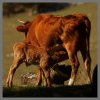-

Apr
11
Interpretive Summary: Parental betaine supplementation promotes gosling growth with epigenetic modulation of IGF gene family in the liver

The goose industry plays important roles in economics, cultures, and ecosystems, yet the low laying and growth rates of many indigenous breeds hinders the development of the goose farming. Betaine, an important methyl donor, is commonly used as a feed additive in livestock and poultry to enhance animal growth.
Read more
-

Apr
04
Interpretive Summary: The effects of including sprouted barley with alfalfa hay in the diet on ruminal health and performance of cow-calf pairs

Climate variability and uncertainty associated with weather patterns can greatly impact feed security for cattle producers. Flooding, drought, and temperature extremes can reduce a farmer’s ability to produce a consistent crop, resulting in feed prices that can fluctuate greatly.
Read more
-

Apr
04
Interpretive Summary: Effect of continuous or intermittent feeding of ergot contaminated grain in a mash or pelleted form on the performance and health of feedlot beef steers

Produced by the fungus Claviceps purpurea, ergot alkaloids (EA) are toxic to beef cattle when consumed and can lead to reduction in feed intake and growth performance, vasoconstriction of the blood vessels, hyperthermia, damage to extremities (ears, tails, and hooves) and in severe cases, death.
Read more
-

Apr
04
Interpretive Summary: Efficacy of a novel multi-enzyme feed additive on growth performance, nutrient digestibility, and gut microbiome of weanling pigs fed corn–wheat or wheat–barley-based diet

There is a pressing need to enhance livestock production efficiency to meet the growing global demand for meat. Carbohydrases and proteases are enzymes typically added to swine diets to improve nutrient utilization, leading to better growth rates and feed efficiency. This ultimately contributes to sustainable and economically viable pig farming.
Read more
-

Apr
04
Interpretive Summary: Unveiling the Genetic Landscape of Feed Efficiency in Holstein Dairy Cows: Insights into Heritability, Genetic Markers, and Pathways via Meta-Analysis

A thorough understanding of the genetic factors that influence the feed efficiency of dairy cows is a prerequisite for planning and implementing selective breeding programs. Therefore, a systematic review of reported heritability, genetic markers, and biological pathways affecting FE-related traits in Holstein dairy cows was conducted and followed by a meta-analysis.
Read more
-

Apr
04
Interpretive Summary: Effects of a novel dental chew on oral health outcomes, halitosis, and microbiota of adult dogs

In this study, we aimed to determine the effects of a novel dental chew on the breath odor, oral health outcomes, and oral microbiota of dogs. Healthy adult dogs were used in a crossover design study to test a diet only (control) or the diet plus a novel dental chew.
Read more
-

Apr
01
12th Nutrient Requirements of Swine Committee is Underway
The National Academy of Sciences, Engineering and Medicine (NASEM) has established the committee to develop the 12th Nutrient Requirements of Swine. The committee has already met in person twice and on-line three times with annual in-person and monthly on-line meetings scheduled for the future. NASEM’s charge to the committee is to “conduct an in-depth review of the scientific literature on the nutritional needs of swine and prepare a report that revises and updates the 11th edition of Nutrient Requirements of Swine.”
Read more
-

Mar
28
Interpretive Summary: Animal ag industry supports the America’s Wildlife Habitat Conservation Act

Representative Bruce Westerman introduced America’s Wildlife Habitat Conservation Act (AWHCA) into the House of Representatives to fund habitat restoration and forest management projects and promote collaboration with private partners to conserve habitat for at-risk and listed species. The AWHCA will also provide $20 million to fund habitat restoration projects and forest management on tribal lands.
Read more
-

Mar
28
Interpretive Summary: Final rule issues for the Packers and Stockers Act

The United States Department of Agriculture (USDA) has announced the finalization of the Inclusive Competition and Market Integrity Under the Packers and Stockyards Act. The final rule will be effective for 60 days following publishing in the Federal Register and is designed to establish clearer, more effective standards under the Packers and Stockyards (P&S) Act for prohibited practices relating to discrimination, retaliation, and deception in contracting.
Read more
-

Mar
28
Interpretive Summary: January US meat export data released

The United States Department of Agriculture (USDA) released the January 2024 export data, which was compiled by the United States Meat Export Federation (USMEF). Pork and lamb exports were high for January, while beef exports were slightly down. Export value is trending significantly higher than the previous year.
Read more
-

Mar
28
Interpretive Summary: The Rural and Agricultural Income and Savings from Renewable Energy initiative is introduced

The United States Department of Agriculture (USDA) and the United States Department of Energy (DOE) have launched a new program to help farmers cut costs and increase income using underutilized renewable technologies including smaller-scale wind projects. The Rural and Agricultural Income & Savings from Renewable Energy (RAISE) initiative will help 400 individual farmers deploy smaller-scale wind projects using USDA’s Rural Energy for America Program (REAP).
Read more
-

Mar
28
Interpretive Summary: The US House Ag Labor Working Group release final report

The United States House Agricultural Working Group has released its final report with policy recommendations. The bipartisan working group participated in extensive discussions with producers across the nation to identify key challenges faced by the industry The goal of the report is to bolster the agricultural workforce.
Read more
-

Mar
28
Interpretive Summary: USDA finalized the Product of USA label claim

The United States Department of Agriculture’s (USDA’s) Food Safety and Inspection Service (FSIS) has announced the finalization of the voluntary “Product of USA” label claim. FSIS is amending its regulations to define the conditions under which the labeling of meat, poultry, and egg products under mandatory inspection, as well as voluntarily inspected products, may use voluntary label claims indicating that the product is of United States origin.
Read more
-

Mar
21
Interpretive Summary: Elucidating the factors and consequences of the severity of rumen acidosis in first-lactation Holstein cows during transition and early lactation

The present study reports a high variation of severity of subacute rumen acidosis in first-lactation dairy cows with the same feeding regimen close to parturition and until 10 weeks after parturition. Six significant factors influencing this severity were identified, including in particular length of close-up period, age at parturition, and dry matter intake.
Read more
-

Mar
21
Interpretive Summary: Comparison between multiple-trait and random regression models for genetic evaluation of weight traits in Australian meat sheep

Currently, multiple-trait (MT) models are used in large-scale genetic evaluation of growth traits, where body weight traits are defined as separate traits at a finite number of fixed ages. Random regression (RR) models are expected to be superior since they can handle repeated measurements of weight and model these as a function of the actual age of measurement.
Read more
-

Mar
21
Interpretive Summary: Unravelling novel and pleiotropic genes for cannon bone circumference and bone mineral density in Yorkshire pigs

Leg weakness, a highly prevalent health condition in pig breeding farms, adversely affects the lifespan of breeding pigs. The augmentation of cannon bone circumference (CBC) and bone mineral density (BMD), which are objective measures of limb strength in pigs, can effectively alleviate leg weakness.
Read more
-

Mar
21
Interpretive Summary: Identification and screening of circular RNAs during adipogenic differentiation of ovine preadipocyte by RNA-seq

The moderate fat deposition contributes to improve mutton quality, which is associated with the differentiation of preadipocytes. To investigate roles of circular RNAs (circRNAs) in preadipocyte differentiation, we identified circRNAs on days 0, 2, and 8 of preadipocytes differentiation and compared the expression profile of circRNAs at different adipogenic differentiation stages.
Read more
-

Mar
21
Interpretive Summary: Technical note: ShinyAnimalCV: open-source cloud-based web application for object detection, segmentation, and three-dimensional visualization of animals using computer vision

The integration of cameras and data science has great potential to revolutionize livestock production systems, making them more efficient and sustainable by replacing human-based management with real-time individualized animal care. However, applying these digital tools to animal data presents challenges that require computer programming and data analysis skills, as well as access to computing resources.
Read more
-

Mar
17
Jim Oltjen's Animal Science Family Tree and Legacy
Jim Oltjen's family history of animal scientists spans three generations, and ASAS has been part of that journey since 1958. They have been mentored by and mentors to those who are now lifelong friends. He and his wife, Sharon, encourage you to reflect on your animal science family tree and ASAS journey and urge you to consider your legacy with ASAS by becoming a 1908 Society Member and ensuring a bright future for aspiring animal scientists.
Read more
-

Mar
14
Interpretive Summary: Green banana flour as a novel functional ingredient in retorted feline diets

Green banana flour (GBF) is a novel ingredient in the pet food industry but has been gaining popularity in human nutrition. Not only can GBF be a source of dietary fiber in pet foods, but the natural brown color and hygroscopic properties also show the potential in contributing to physical characteristics.
Read more
 AprInterpretive Summary: Parental betaine supplementation promotes gosling growth with epigenetic modulation of IGF gene family in the liver
AprInterpretive Summary: Parental betaine supplementation promotes gosling growth with epigenetic modulation of IGF gene family in the liver The goose industry plays important roles in economics, cultures, and ecosystems, yet the low laying and growth rates of many indigenous breeds hinders the development of the goose farming. Betaine, an important methyl donor, is commonly used as a feed additive in livestock and poultry to enhance animal growth.
The goose industry plays important roles in economics, cultures, and ecosystems, yet the low laying and growth rates of many indigenous breeds hinders the development of the goose farming. Betaine, an important methyl donor, is commonly used as a feed additive in livestock and poultry to enhance animal growth. AprInterpretive Summary: The effects of including sprouted barley with alfalfa hay in the diet on ruminal health and performance of cow-calf pairs
AprInterpretive Summary: The effects of including sprouted barley with alfalfa hay in the diet on ruminal health and performance of cow-calf pairs Climate variability and uncertainty associated with weather patterns can greatly impact feed security for cattle producers. Flooding, drought, and temperature extremes can reduce a farmer’s ability to produce a consistent crop, resulting in feed prices that can fluctuate greatly.
Climate variability and uncertainty associated with weather patterns can greatly impact feed security for cattle producers. Flooding, drought, and temperature extremes can reduce a farmer’s ability to produce a consistent crop, resulting in feed prices that can fluctuate greatly. AprInterpretive Summary: Effect of continuous or intermittent feeding of ergot contaminated grain in a mash or pelleted form on the performance and health of feedlot beef steers
AprInterpretive Summary: Effect of continuous or intermittent feeding of ergot contaminated grain in a mash or pelleted form on the performance and health of feedlot beef steers Produced by the fungus Claviceps purpurea, ergot alkaloids (EA) are toxic to beef cattle when consumed and can lead to reduction in feed intake and growth performance, vasoconstriction of the blood vessels, hyperthermia, damage to extremities (ears, tails, and hooves) and in severe cases, death.
Produced by the fungus Claviceps purpurea, ergot alkaloids (EA) are toxic to beef cattle when consumed and can lead to reduction in feed intake and growth performance, vasoconstriction of the blood vessels, hyperthermia, damage to extremities (ears, tails, and hooves) and in severe cases, death. AprInterpretive Summary: Efficacy of a novel multi-enzyme feed additive on growth performance, nutrient digestibility, and gut microbiome of weanling pigs fed corn–wheat or wheat–barley-based diet
AprInterpretive Summary: Efficacy of a novel multi-enzyme feed additive on growth performance, nutrient digestibility, and gut microbiome of weanling pigs fed corn–wheat or wheat–barley-based diet There is a pressing need to enhance livestock production efficiency to meet the growing global demand for meat. Carbohydrases and proteases are enzymes typically added to swine diets to improve nutrient utilization, leading to better growth rates and feed efficiency. This ultimately contributes to sustainable and economically viable pig farming.
There is a pressing need to enhance livestock production efficiency to meet the growing global demand for meat. Carbohydrases and proteases are enzymes typically added to swine diets to improve nutrient utilization, leading to better growth rates and feed efficiency. This ultimately contributes to sustainable and economically viable pig farming. AprInterpretive Summary: Unveiling the Genetic Landscape of Feed Efficiency in Holstein Dairy Cows: Insights into Heritability, Genetic Markers, and Pathways via Meta-Analysis
AprInterpretive Summary: Unveiling the Genetic Landscape of Feed Efficiency in Holstein Dairy Cows: Insights into Heritability, Genetic Markers, and Pathways via Meta-Analysis A thorough understanding of the genetic factors that influence the feed efficiency of dairy cows is a prerequisite for planning and implementing selective breeding programs. Therefore, a systematic review of reported heritability, genetic markers, and biological pathways affecting FE-related traits in Holstein dairy cows was conducted and followed by a meta-analysis.
A thorough understanding of the genetic factors that influence the feed efficiency of dairy cows is a prerequisite for planning and implementing selective breeding programs. Therefore, a systematic review of reported heritability, genetic markers, and biological pathways affecting FE-related traits in Holstein dairy cows was conducted and followed by a meta-analysis. AprInterpretive Summary: Effects of a novel dental chew on oral health outcomes, halitosis, and microbiota of adult dogs
AprInterpretive Summary: Effects of a novel dental chew on oral health outcomes, halitosis, and microbiota of adult dogs In this study, we aimed to determine the effects of a novel dental chew on the breath odor, oral health outcomes, and oral microbiota of dogs. Healthy adult dogs were used in a crossover design study to test a diet only (control) or the diet plus a novel dental chew.
In this study, we aimed to determine the effects of a novel dental chew on the breath odor, oral health outcomes, and oral microbiota of dogs. Healthy adult dogs were used in a crossover design study to test a diet only (control) or the diet plus a novel dental chew. Apr12th Nutrient Requirements of Swine Committee is Underway
Apr12th Nutrient Requirements of Swine Committee is Underway MarInterpretive Summary: Animal ag industry supports the America’s Wildlife Habitat Conservation Act
MarInterpretive Summary: Animal ag industry supports the America’s Wildlife Habitat Conservation Act Representative Bruce Westerman introduced America’s Wildlife Habitat Conservation Act (AWHCA) into the House of Representatives to fund habitat restoration and forest management projects and promote collaboration with private partners to conserve habitat for at-risk and listed species. The AWHCA will also provide $20 million to fund habitat restoration projects and forest management on tribal lands.
Representative Bruce Westerman introduced America’s Wildlife Habitat Conservation Act (AWHCA) into the House of Representatives to fund habitat restoration and forest management projects and promote collaboration with private partners to conserve habitat for at-risk and listed species. The AWHCA will also provide $20 million to fund habitat restoration projects and forest management on tribal lands. MarInterpretive Summary: Final rule issues for the Packers and Stockers Act
MarInterpretive Summary: Final rule issues for the Packers and Stockers Act The United States Department of Agriculture (USDA) has announced the finalization of the Inclusive Competition and Market Integrity Under the Packers and Stockyards Act. The final rule will be effective for 60 days following publishing in the Federal Register and is designed to establish clearer, more effective standards under the Packers and Stockyards (P&S) Act for prohibited practices relating to discrimination, retaliation, and deception in contracting.
The United States Department of Agriculture (USDA) has announced the finalization of the Inclusive Competition and Market Integrity Under the Packers and Stockyards Act. The final rule will be effective for 60 days following publishing in the Federal Register and is designed to establish clearer, more effective standards under the Packers and Stockyards (P&S) Act for prohibited practices relating to discrimination, retaliation, and deception in contracting. MarInterpretive Summary: January US meat export data released
MarInterpretive Summary: January US meat export data released The United States Department of Agriculture (USDA) released the January 2024 export data, which was compiled by the United States Meat Export Federation (USMEF). Pork and lamb exports were high for January, while beef exports were slightly down. Export value is trending significantly higher than the previous year.
The United States Department of Agriculture (USDA) released the January 2024 export data, which was compiled by the United States Meat Export Federation (USMEF). Pork and lamb exports were high for January, while beef exports were slightly down. Export value is trending significantly higher than the previous year. MarInterpretive Summary: The Rural and Agricultural Income and Savings from Renewable Energy initiative is introduced
MarInterpretive Summary: The Rural and Agricultural Income and Savings from Renewable Energy initiative is introduced The United States Department of Agriculture (USDA) and the United States Department of Energy (DOE) have launched a new program to help farmers cut costs and increase income using underutilized renewable technologies including smaller-scale wind projects. The Rural and Agricultural Income & Savings from Renewable Energy (RAISE) initiative will help 400 individual farmers deploy smaller-scale wind projects using USDA’s Rural Energy for America Program (REAP).
The United States Department of Agriculture (USDA) and the United States Department of Energy (DOE) have launched a new program to help farmers cut costs and increase income using underutilized renewable technologies including smaller-scale wind projects. The Rural and Agricultural Income & Savings from Renewable Energy (RAISE) initiative will help 400 individual farmers deploy smaller-scale wind projects using USDA’s Rural Energy for America Program (REAP). MarInterpretive Summary: The US House Ag Labor Working Group release final report
MarInterpretive Summary: The US House Ag Labor Working Group release final report The United States House Agricultural Working Group has released its final report with policy recommendations. The bipartisan working group participated in extensive discussions with producers across the nation to identify key challenges faced by the industry The goal of the report is to bolster the agricultural workforce.
The United States House Agricultural Working Group has released its final report with policy recommendations. The bipartisan working group participated in extensive discussions with producers across the nation to identify key challenges faced by the industry The goal of the report is to bolster the agricultural workforce. MarInterpretive Summary: USDA finalized the Product of USA label claim
MarInterpretive Summary: USDA finalized the Product of USA label claim The United States Department of Agriculture’s (USDA’s) Food Safety and Inspection Service (FSIS) has announced the finalization of the voluntary “Product of USA” label claim. FSIS is amending its regulations to define the conditions under which the labeling of meat, poultry, and egg products under mandatory inspection, as well as voluntarily inspected products, may use voluntary label claims indicating that the product is of United States origin.
The United States Department of Agriculture’s (USDA’s) Food Safety and Inspection Service (FSIS) has announced the finalization of the voluntary “Product of USA” label claim. FSIS is amending its regulations to define the conditions under which the labeling of meat, poultry, and egg products under mandatory inspection, as well as voluntarily inspected products, may use voluntary label claims indicating that the product is of United States origin. MarInterpretive Summary: Elucidating the factors and consequences of the severity of rumen acidosis in first-lactation Holstein cows during transition and early lactation
MarInterpretive Summary: Elucidating the factors and consequences of the severity of rumen acidosis in first-lactation Holstein cows during transition and early lactation The present study reports a high variation of severity of subacute rumen acidosis in first-lactation dairy cows with the same feeding regimen close to parturition and until 10 weeks after parturition. Six significant factors influencing this severity were identified, including in particular length of close-up period, age at parturition, and dry matter intake.
The present study reports a high variation of severity of subacute rumen acidosis in first-lactation dairy cows with the same feeding regimen close to parturition and until 10 weeks after parturition. Six significant factors influencing this severity were identified, including in particular length of close-up period, age at parturition, and dry matter intake. MarInterpretive Summary: Comparison between multiple-trait and random regression models for genetic evaluation of weight traits in Australian meat sheep
MarInterpretive Summary: Comparison between multiple-trait and random regression models for genetic evaluation of weight traits in Australian meat sheep Currently, multiple-trait (MT) models are used in large-scale genetic evaluation of growth traits, where body weight traits are defined as separate traits at a finite number of fixed ages. Random regression (RR) models are expected to be superior since they can handle repeated measurements of weight and model these as a function of the actual age of measurement.
Currently, multiple-trait (MT) models are used in large-scale genetic evaluation of growth traits, where body weight traits are defined as separate traits at a finite number of fixed ages. Random regression (RR) models are expected to be superior since they can handle repeated measurements of weight and model these as a function of the actual age of measurement. MarInterpretive Summary: Unravelling novel and pleiotropic genes for cannon bone circumference and bone mineral density in Yorkshire pigs
MarInterpretive Summary: Unravelling novel and pleiotropic genes for cannon bone circumference and bone mineral density in Yorkshire pigs Leg weakness, a highly prevalent health condition in pig breeding farms, adversely affects the lifespan of breeding pigs. The augmentation of cannon bone circumference (CBC) and bone mineral density (BMD), which are objective measures of limb strength in pigs, can effectively alleviate leg weakness.
Leg weakness, a highly prevalent health condition in pig breeding farms, adversely affects the lifespan of breeding pigs. The augmentation of cannon bone circumference (CBC) and bone mineral density (BMD), which are objective measures of limb strength in pigs, can effectively alleviate leg weakness. MarInterpretive Summary: Identification and screening of circular RNAs during adipogenic differentiation of ovine preadipocyte by RNA-seq
MarInterpretive Summary: Identification and screening of circular RNAs during adipogenic differentiation of ovine preadipocyte by RNA-seq The moderate fat deposition contributes to improve mutton quality, which is associated with the differentiation of preadipocytes. To investigate roles of circular RNAs (circRNAs) in preadipocyte differentiation, we identified circRNAs on days 0, 2, and 8 of preadipocytes differentiation and compared the expression profile of circRNAs at different adipogenic differentiation stages.
The moderate fat deposition contributes to improve mutton quality, which is associated with the differentiation of preadipocytes. To investigate roles of circular RNAs (circRNAs) in preadipocyte differentiation, we identified circRNAs on days 0, 2, and 8 of preadipocytes differentiation and compared the expression profile of circRNAs at different adipogenic differentiation stages. MarInterpretive Summary: Technical note: ShinyAnimalCV: open-source cloud-based web application for object detection, segmentation, and three-dimensional visualization of animals using computer vision
MarInterpretive Summary: Technical note: ShinyAnimalCV: open-source cloud-based web application for object detection, segmentation, and three-dimensional visualization of animals using computer vision The integration of cameras and data science has great potential to revolutionize livestock production systems, making them more efficient and sustainable by replacing human-based management with real-time individualized animal care. However, applying these digital tools to animal data presents challenges that require computer programming and data analysis skills, as well as access to computing resources.
The integration of cameras and data science has great potential to revolutionize livestock production systems, making them more efficient and sustainable by replacing human-based management with real-time individualized animal care. However, applying these digital tools to animal data presents challenges that require computer programming and data analysis skills, as well as access to computing resources. MarJim Oltjen's Animal Science Family Tree and Legacy
MarJim Oltjen's Animal Science Family Tree and Legacy MarInterpretive Summary: Green banana flour as a novel functional ingredient in retorted feline diets
MarInterpretive Summary: Green banana flour as a novel functional ingredient in retorted feline diets Green banana flour (GBF) is a novel ingredient in the pet food industry but has been gaining popularity in human nutrition. Not only can GBF be a source of dietary fiber in pet foods, but the natural brown color and hygroscopic properties also show the potential in contributing to physical characteristics.
Green banana flour (GBF) is a novel ingredient in the pet food industry but has been gaining popularity in human nutrition. Not only can GBF be a source of dietary fiber in pet foods, but the natural brown color and hygroscopic properties also show the potential in contributing to physical characteristics.



